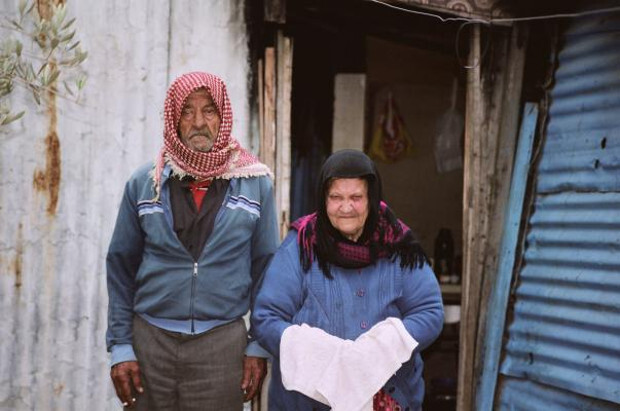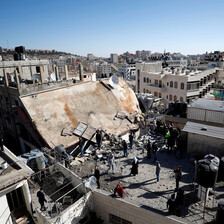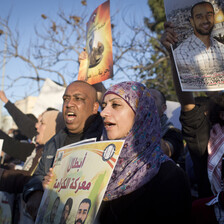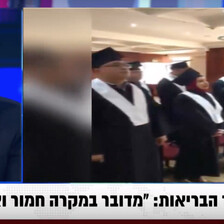The Electronic Intifada 2 February 2015

Yousef Hassan and his wife Amna in Salim Abu Jabal’s Roshmia.
The representation of the city of Haifa as a model for coexistence between Palestinians and Israelis overlooks the gradual but massive impact Zionist colonialism has wrought.
Although not quite as flagrant and aggressive as the ethnic cleansing of another coastal city, Jaffa, Haifa has endured its own Nakba — the ethnic cleansing of Palestine — since 1948.
Roshmia valley, in the eastern edge of the city, is where colonial dominance and gentrification dressed in the euphemisms of modernity and development conspire. The area epitomizes Israel’s attempts at corroding Palestinian identity and existence in the city.
It is this very struggle for existence and survival that the documentary film Roshmia so poignantly portrays.
A recipient of the jury prize at the 2014 Dubai International Film Festival, Roshmia was written, edited and directed by Salim Abu Jabal, a Ramallah-based Syrian filmmaker from the occupied Golan Heights.
The seventy-minute documentary delves into the intricacies of everyday life and struggle of an elderly, childless refugee couple as they desperately cling to their shack in Wadi Roshmia.
Displaced
Yousef Hassan, commonly known as Abu al-Abed, sought refuge in a shack in Roshmia valley in 1956 after being displaced from his neighborhood of Wadi al-Salib in downtown Haifa.
For decades, he and his wife Amna, or Um Suleiman, a refugee from the village of Yasoor, have lived quietly in their humble shack with no access to electricity, running water or other basic services. Abu al-Abed’s radio is their sole means of connection with the “outside world.”
Life changed dramatically when the Haifa municipality decided to destroy their shack in order to pave a road to connect the Mediterranean Sea with Mount Carmel. Under the guise of development, the process to bulldoze Wadi Roshmia began at the end of the 1980s with two mega projects: the Grand Canyon shopping mall complex and the Carmel tunnels, both of which drastically affected the route of the valley and its topography.
The evacuation of Wadi Roshmia, continuously inhabited since the Byzantine period, would eventually be completed by the construction of the road and the transformation of the wadi (valley) into a park. The erasure wasn’t solely physical: even the wadi’s original Aramaic name and the bridge above it were changed and renamed after Battalion 22 of the Haganah, responsible for the ethnic cleansing of the eastern part of Haifa in April 1948.
Intimate
It was in this murky context that Yousef and Amna had to navigate a solution. Offered a financial compensation by the municipality in a deal negotiated by their mediator and Yousef’s friend, Aouni Shihadeh, tensions flare up among the three characters.
The slow pace of the film, its focus on the small details and the profound dialogues (subtitled in English) create an intimate connection between the viewers and the characters.
Stressing that Yousef and Amna are both refugees at the outset of the film is key; their battle is unlike any other against a city municipality. The Haifa “municipality” is not like any other municipality: it is an arm of the Israeli occupation. And theirs is a battle by an indigenous Palestinian couple against an occupation authority and a second, even more traumatic displacement.
While they were young they were displaced from their original towns for the first time. Now they are not only forced to look for another home, but they have to start all over again at almost eighty years old, when all they wanted was stability.
The terminology used by the couple is telling. They do not use a citizenship-inspired lexicon. They refer to the municipality as the “government,” and there is little difference between the authority that displaced them in the wake of the Nakba and the authority willing to displace them now.
“Even if the entire government of Israel comes, I’m not going to leave my home,” affirms Abu al-Abed in one instance.
Meanwhile, their mediator, Aouni, resorts to an entirely different language — both the language of a merchant and a citizen. He’s pragmatic. He’s angry at the Haifa municipality’s failure to provide Yousef and Amna with basic services, but he’s willing to mediate between the couple and the municipality. Amna and Yousef, on the other hand, do not even acknowledge the legitimacy of the municipality.
While Yousef is vocal in his opposition to the eviction, Amna just wants out of the wadi. Her position might be thought of as a realistic stance. A thorough observation of the evolution of her personality, though, convinces us that Amna is a feminist.
Indeed, as the film goes on, viewers see her personal redemption when it is least expected.
At the beginning of the film, Amna appears a passive character, eating oranges; her voice is barely audible when she speaks about her native Yasoor. Amna’s accent is not at all influenced by the urban Haifa accent, but is much like the dialect spoken in some areas in Gaza.
Gradually, however, we see a different Amna. She insists on her resolution to lead an independent life, to get the hell out of Haifa and to “go back to my country.”
Even at nearly eighty, Um Suleiman still feels that there are many things still worth fighting for and an entire life ahead of her. She mutters about her future plans while smoking her cigarettes.
Amna is a feminist peasant without tags and badges, making the documentary as much a Palestinian story as it is a feminist one.
Bottom of the world
Striking in the film is the absence of Israeli characters, save for on two occasions: the first when the lights of an Israeli colony appear high above as Amna and Yousef argue. The neighborhoods overseeing the wadi in the abyss illustrate that the couple are not just at the bottom of the world figuratively, but also literally.
The second appearance of Israelis comes with the arrival of bulldozers to destroy the shack. There is no physical violence, no beating and no confrontation. The symbolic violence and ruthless efficiency with which the operation is carried out speaks louder than bombs and screams. It is this side of Israeli colonialism that is rarely caught on camera but no less devastating than violent assaults. And in Roshmia, Abu Jabal succeeds in illustrating this.
The shack
“The shack is the Palestinian tent,” Roshmia filmmaker Abu Jabal told The Electronic Intifada. “In the 1950s Palestinians replaced their tents with cement housing in refugee camps, but the shack became the new tent.”
“Yousef and his wife are perhaps among the last remaining shack-dwellers and in many ways the destruction of their shack is the destruction of the refugee tent,” he explained.
Roshmia took six years to film, but most of the feature’s scenes take place between 2006 and 2008. When asked why it took so long for the film to see the light, Abu Jabal said, “First, it took a very long time to edit the film. I had to teach myself editing bit by bit. And it is while editing the film that I actually developed the synopsis. It was grueling to pick seventy minutes out of over forty hours of filmed footage.”
He added that allocating funds for the film was a challenge because he was adamant not to receive funding by any Israeli group.
Abu Jabal’s Roshmia is not the first film about the Roshmia valley. Israeli director Amos Gitai directed a trilogy about the wadi, but the differences between the two couldn’t be greater.
Abu Jabal wasn’t aware of Gitai’s trilogy when he started filming. It was later that he actually watched them. While Gitai’s trilogy follows the characters through different stages of their lives, it tries to depict a false image of coexistence between Israelis and Palestinians in Roshmia.
In their attempts to highlight Israel’s brutality, many Palestinian documentaries compromise artistic quality in exchange for drama. Roshmia, though, avoids this trap and its aesthetic value and powerful dialogues make it one of the best features about Palestine in recent years.
Budour Youssef Hassan is a Palestinian anarchist and law graduate based in occupied Jerusalem. She can be followed on Twitter: @Budour48.





